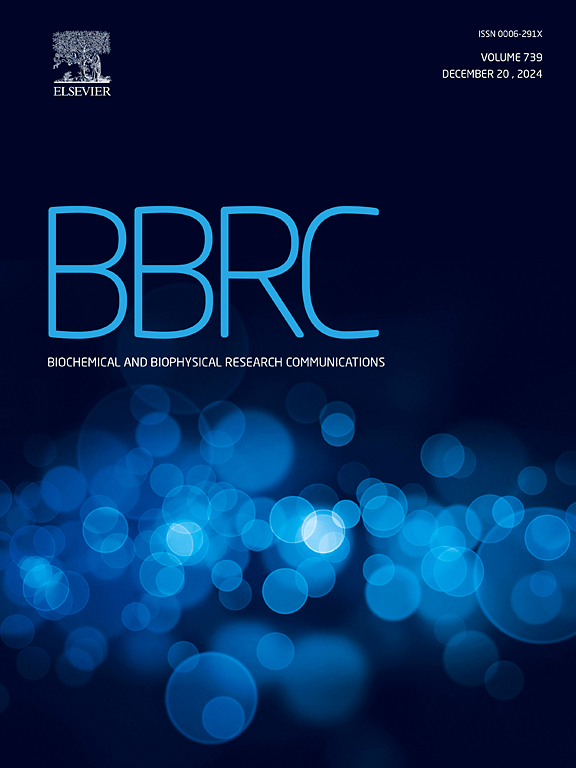Conditional knockout mouse model demonstrates that Copa expression is required for viability in development and adulthood
IF 2.2
3区 生物学
Q3 BIOCHEMISTRY & MOLECULAR BIOLOGY
Biochemical and biophysical research communications
Pub Date : 2025-06-14
DOI:10.1016/j.bbrc.2025.152201
引用次数: 0
Abstract
The COPI coatomer is a heptameric complex that regulates traffic between the Golgi apparatus and the Endoplasmic Reticulum (ER). Mutations in the COPA gene encoding the alpha subunit of the COPI complex result in an autoimmune disorder impacting multiple tissues including the lungs, joints, and kidneys. We report here the characterization of a conditional-ready Copa knockout mouse. Systemic homozygous deletion of Copa in mice resulted in embryonic lethality. Deletion of Copa in Chat-positive cells also resulted in late embryonic lethality. However, the deletion of Copa by Cre recombinase expression under the Mnx1 promoter was compatible with development and viability. In adulthood, these mice display a modest glucose intolerance, most likely due to Mnx1-driven pancreatic expression of Cre recombinase. Systemic deletion of Copa in adult mice results in rapid decline and death. Lung fibroblasts cultured from mice expressing a Tamoxifen-inducible Cre recombinase demonstrate robust Copa knockout, resulting in near complete loss of alpha-COP protein. These cultures recapitulate the previously described COPA syndrome phenotype, including hyperactivation of STING (Stimulator of Interferon Genes) signaling and induction of ER stress. Dorsal Root Ganglion neurons cultured from Tamoxifen-inducible Copa knockout mice show that axonal arbor maintenance and viability requires Copa expression.
条件敲除小鼠模型表明Copa的表达是发育和成年生存能力所必需的
COPI包衣体是一种七聚体复合物,调节高尔基体和内质网之间的交通。编码COPI复合物α亚基的COPA基因突变可导致影响包括肺、关节和肾脏在内的多种组织的自身免疫性疾病。我们在这里报告了条件准备Copa敲除小鼠的特征。小鼠体内Copa的系统性纯合缺失导致胚胎死亡。在chat阳性细胞中,Copa的缺失也会导致胚胎晚期死亡。然而,在Mnx1启动子下,Cre重组酶表达Copa的缺失与发育和生存能力是相容的。在成年期,这些小鼠表现出适度的葡萄糖耐受不良,很可能是由于mnx1驱动的Cre重组酶的胰腺表达。在成年小鼠中,Copa的系统性缺失导致快速衰退和死亡。从表达他莫昔芬诱导的Cre重组酶的小鼠培养的肺成纤维细胞显示出强劲的Copa敲除,导致α - cop蛋白几乎完全丧失。这些培养概括了先前描述的COPA综合征表型,包括STING(干扰素基因刺激因子)信号的过度激活和内质网应激的诱导。从他莫昔芬诱导的Copa基因敲除小鼠培养的背根神经节神经元表明,轴突乔木的维持和活力需要Copa的表达。
本文章由计算机程序翻译,如有差异,请以英文原文为准。
求助全文
约1分钟内获得全文
求助全文
来源期刊
CiteScore
6.10
自引率
0.00%
发文量
1400
审稿时长
14 days
期刊介绍:
Biochemical and Biophysical Research Communications is the premier international journal devoted to the very rapid dissemination of timely and significant experimental results in diverse fields of biological research. The development of the "Breakthroughs and Views" section brings the minireview format to the journal, and issues often contain collections of special interest manuscripts. BBRC is published weekly (52 issues/year).Research Areas now include: Biochemistry; biophysics; cell biology; developmental biology; immunology
; molecular biology; neurobiology; plant biology and proteomics

 求助内容:
求助内容: 应助结果提醒方式:
应助结果提醒方式:


